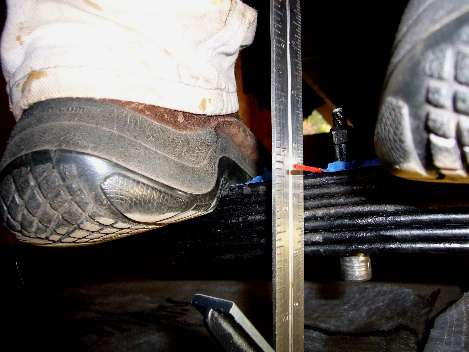The MGA With An Attitude
LEAF SPRINGS, Spring Rate vs. Height -- RS-105A
In prior articles spring rate is usually ignored, because it doesn't change much with age or use of springs. Leaf springs (or any springs) may sag a little if left under load for decades of time. This sag is in the form of a permanent set where the spring will not return to original height when it is unloaded, but the modulus of elasticity (springiness of the metal) and spring rate doesn't change. If the leaf thickness would change, then the spring rate would change. Leaves might get thinner with long term frictional wear. Leaves might be thicker or thinner when you buy new springs. I believe the manufacturers get the leaf thickness right with new springs, but often get the curvature wrong (usually too tall). This article will be a discussion about spring rate and it's affect on ride height.

As previously noted, the leaf spring should end up flat when full laden, and there is a way to check this in real world conditions. Fill the fuel tank, put a generous amount of tools or other luggage in the boot, put two adult people in the seats, and then measure the leaf springs. A drive on hoist would be nice here, but a pair of wheel ramps, a floor jack and a flat floor will suffice. You can put the front wheels on ramps, then jack up the rear with jack under center of the differential to make the car approximately level. You could otherwise put the rear wheels on ramps, and jack under the center of the front suspension cross member to make the car approximately level. Either way results in fully loaded leaf springs. Then you can inspect and measure the leaf springs to see if they are very close to being flat.
For calculating the spring rate you need to carefully measure thickness of the leaves. This is easy with new springs. You might measure total thickness of the spring stack near the center, then divide by number of leafs to get the thickness of each leaf. But this is trickier with worn springs. Leaf springs wear in the area of physical contact between the leaves. For used springs you would need to disassemble them to measure leaf thickness in the area of leaf physical contact.
Now we can have some fun with numbers. The leaves should be 7/32" (0.219") thick. Spring strength and spring rate increase as the cube of leaf thickness. If the leaf is 0.031" too thick you get (0.250/0.219)^3=1.49
That's 50% higher spring rate, or 2/3 as much deflection with a given load. Rather than deflecting 3.6" with full load it will only deflect 2.42". Add that 1.2" difference to the 0.6" excess free height to get total excess height of 1.8" when fully loaded.
You might also try measuring spring rate more directly. Place spring upside down and carefully measure the unladen height. Then apply a heavy load and measure height again. Difference in load divided by difference in height is the spring rate. Spring rate should be 125 lb/in. Got any bar bell weights around? Put 250 lb on the the spring, and it should deflect 2". If you measure any different spring rate I would be delighted to know what you find.

As to assembling the rebound strap on a bare chassis (no car body present), this is a bit of a tickler. The frame will never sit low enough until it has the body installed, pretty much completely assembled. Without the body on the car you can't tell much about ride height except by measuring spring rate of the specific leaf spring, and doing the calculations. The only load on the spring is the rear half of the bare frame, shock absorber, shock link, rebound buffer, rebound strap. You don't count weight of the rear axle, because it sits on the floor below the spring (unsprung weight).
When the car is fully assembled and fully laden, load should be 450 pounds on each leaf spring, and the spring should be flat. Curb weight is defined as no load and 2-gallons of fuel in the tank, with spare tire and the traveling tools on board. The load is two adult passengers, another 10 gallons of fuel (full tank), and maybe 50 pounds of luggage in the boot. Since fuel and luggage is aft of the rear axle, multiply by 1.25x. Passengers sit about 2/3 back between front and rear axle, so multiply by 0.67x. (200x2x0.67)+(10x6.5x1.25)=348 lb added to the rear axle, or 174 lb added to each rear spring. 174/125=1.4" deflection due to the load. Original free camber is 3.6", so deflection at curb weight should be 3.6-1.4 - 2.2". It stands to reason that curb weight should be about 2.2x125=275 pounds per leaf spring.
Suppose you are working with a bare frame chassis, rear axle and springs in place but no engine, gearbox, body or fuel tank. Then you need to add about 500 pounds load to the rear suspension, or about 400 pounds load on the frame rear cross member, to get it loaded to the equivalent of "curb weight". When you do that you should be able to install the rebound straps with a little slack.
|